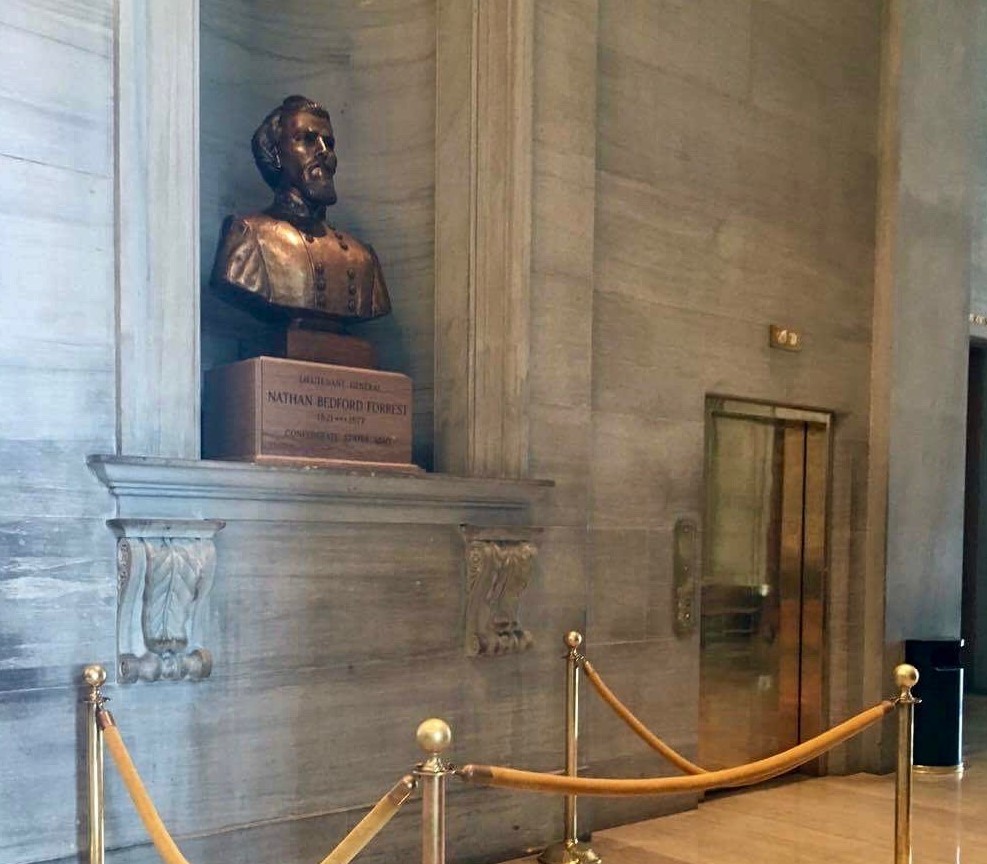By the time you read this, the State Capitol Commission will probably have voted to comply with Gov. Bill Lee’s request to remove the bust of Confederate General Nathan Bedford Forrest from its pedestal in the state capitol and place it in a more appropriate location. Lee recommends the state museum, where Forrest’s legacy – slave trader, war hero, accused war criminal, first Grand Wizard of the Ku Klux Klan – can be put into context and considered in a nuanced, historically accurate setting.
Lee said his decision has nothing to do with the Black Lives Matter protests that have roiled the country this summer, but implied that he had been influenced by hearing from thousands of Tennesseans with opinions about Nathan Bedford Forrest.
“Symbols matter,” said the governor, who was embarrassed during his campaign when an old photo of him in Confederate drag during his undergraduate days at Auburn turned up on social media and was widely shared.
“Forrest represents pain and suffering and brutal crimes committed against African Americans, and that pain is very real for our fellow Tennesseans,” Lee said. “Controversy over the Nathan Bedford Forrest bust began long before all of this national ruckus on monuments that we’re seeing play out today.”
Lee said “mob rule” is forcing statues to come down across the country – but not here.
The relocation isn’t a done deal yet – the state historical commission also must approve it – but a short trip across the street to the state museum appears to be in the cards for the Wizard of the Saddle.
I used to puzzle over why the memory of a slave trader/war criminal/Klansman was so revered, and I’m almost glad I didn’t know that we have the late state Sen. Doug Henry to thank. I liked Henry. Everybody did. (Video tribute from former Gov. Winfield Dunn is here.)

Sen. Doug Henry
He was almost universally praised for his honesty, dedication and personal kindliness when he retired from office in 2014 after serving 44 years, making him the longest-serving member of the state Senate. I remember the Foghorn Leghorn drawl, the stubby cigar clenched between his teeth, the twinkly blue eyes and the kind word for everyone who crossed his path.
Because he was a bit on the portly side and tended to waddle when he walked, his friends and family called him “Duck.” He was an early environmentalist and a fiscal conservative who was deeply respected by his peers – beloved isn’t too strong a word.
He also championed some of the most antiquated and hurtful positions that I had ever encountered – like opposing abortion even in cases of rape (which he said are mostly not “real” rape nowadays; just women changing their minds at the last minute) – and keeping adoption records sealed and inaccessible to adoptees searching for their parents.
This was back in the ‘80s, when we could disagree politically and still be friends.
Senator Henry wasn’t a mean man, so I’ve wondered what message he meant to convey to people of color with his devotion to the memory of a Confederate general who got rich off the slave trade and was the commanding officer of troops who committed atrocities because they were infuriated by the sight of former slaves willing to fight for their freedom.
Will the genteel ghost of Doug Henry, who died in 2017 at the age of 90, return to Capitol Hill to haunt his former colleagues if Gen. Forrest gets moved to a more suitable location? Henry’s in-your-face attachment to Forrest in the face of the pain the man had inflicted was a head scratcher. How could someone so nice be so indifferent to human suffering?
While researching this topic, I discovered that Henry was a lifetime member of Sons of the Confederacy. He was also an heir of the National Life and Accident Insurance Co. fortune and a double Vanderbilt graduate (undergraduate and law school), so he was born and bred into privilege. It was all he knew.
And that was evidently enough for him to disregard the testimony of men like Sergeant Benjamin Robinson (Colored), Company D, Sixth United States Heavy Artillery, who told of what happened to him and his fellow Union soldiers when they tried to surrender after Forrest’s troops captured Fort Pillow on April 14, 1864.
Given Henry’s love of history, he could not have failed read the report of the Committee on the Conduct of the War, commissioned by the U.S. Senate to investigate the events at Fort Pillow soon as word of the massacre got out. Interviews were conducted at military hospitals in Cairo and Mound City (Illinois), Columbus (Kentucky). Fort Pillow and Memphis and were completed by April 21.
Here is a summary of Robinson’s testimony of what happened after the battle. He is but one of many, and the stories are very consistent:
Two white soldiers standing near him signaled their willingness to surrender by laying their guns on the ground, but got shot anyway. The body of a black soldier who tried to surrender was blown “clear over into the river.”
Then the Confederate soldiers (frequently called “Secesh” by the Union men) shot Robinson and ordered him to walk up the hill toward them.
“They said, ‘Give me your money, you damned nigger.’ I told them I did not have any. ‘Give me your money, or I will blow your brains out.’ Then they told me to lie down, and I laid down, and they stripped everything off me.”
Robison survived overnight, and the next day other Confederates came up from Memphis, took him into custody and loaded him onto a plank with the intention of taking him onboard.
Question. “Were any rebel officers around when the rebels were killing our men?”
Answer. “Yes, sir; lots of them.”
Question. “Did they try to keep their men from killing our men?”
Answer. “I never heard them say so.”
Forrest’s fans (of whom there are many) say he was not responsible for the war crimes committed at Fort Pillow, either because his troops had gotten “out of control,” or because he wasn’t physically present. Sergeant Robinson, a former slave from South Carolina, flattens that argument. Not only was Forrest there, but he boasted to his captives that he had gotten rich selling the likes of them:
“I know General Forrest rode his horse over me three or four times. I did not know him until I heard his men call his name. He said to some negro men there that he knew them; that they had been in his nigger yard in Memphis. He said he was not worth five dollars when he started, and had got rich trading in negroes.”
Robinson was one of about 600 Union soldiers garrisoned at Fort Pillow, along with a sprinkling of officers’ families and local tradespeople (who were allowed to leave before the battle), escaped slaves and “contraband boys” – black children involuntarily impressed into service, many of whom were executed by the Confederates. The casualty counts differ from source to source, but the likeliest tally was 350 killed and mortally wounded, 60 wounded, 164 captured and missing, with black soldiers doing most of the dying.
The Senate investigators moved incredibly fast, interviewing the grievously wounded soldiers in their hospital beds. They submitted their report, complete with photographs of survivors, on April 21, 1864. Read it here.
Anger built in the North (and in Loyalist strongholds like East Tennessee). “Remember Fort Pillow” became a battle cry. And the Lincoln administration recognized a need to take action to protect its black soldiers, and perhaps to rein them in because they were angry, too. War Secretary Edwin Stanton heard enough to convince him that Forrest deserved to die on the gallows as soon as the opportunity arose. Lincoln, whose eyes were forever on the prize of ending the war and reuniting the nation, declined to follow through.
And Forrest survived to become an icon of the Lost Cause to be worshipped by sons of the South like Doug Henry.
Betty Bean is a journalist for Knox and Sevier counties who writes this weekly opinion column, Knox Scene.

